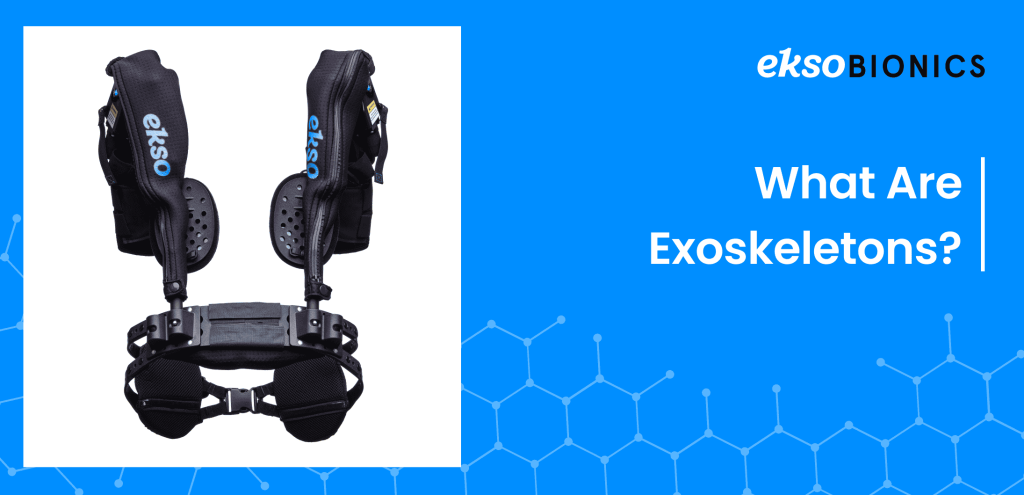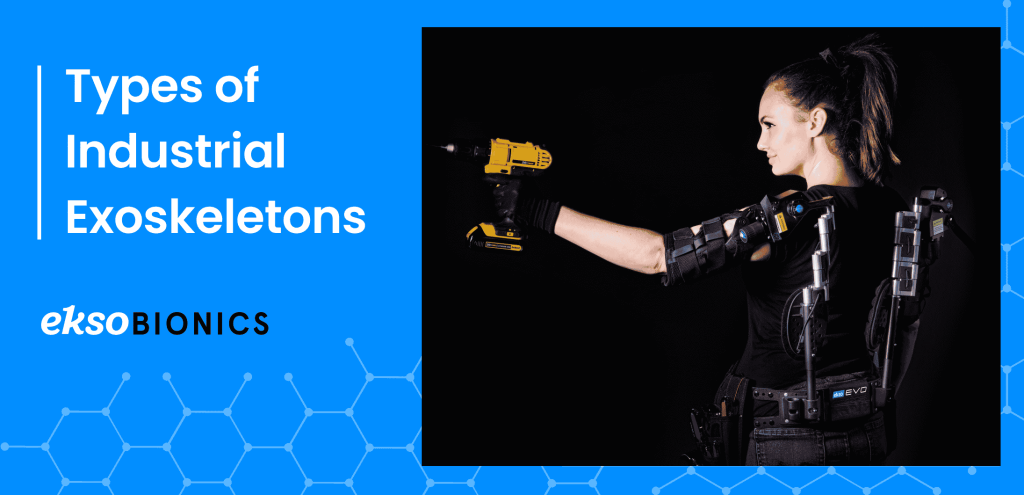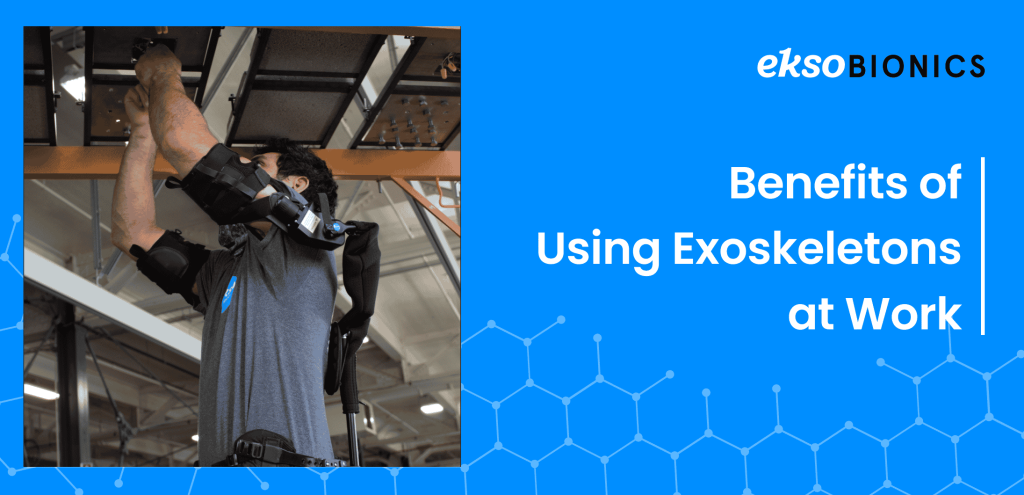Work injuries are any injuries that arise during the course of employment. They may be categorized as traumatic, chronic exposure, psychological or emotional injuries. Among industrial workers, traumatic injuries are the highest due to the physically demanding nature of their jobs. This leads to Workplace Musculoskeletal Disorders (WMSDs) such as strains, sprains, bone fractures, back pain, carpal tunnel syndrome, tendonitis, osteoarthritis, hernia, among others.
Construction and industrial workers are at a higher risk of WMSDs, given the physical demands of their jobs. WMSDs are any conditions that involve soft tissues like muscles, nerves, cartilage, etc. According to the Centers for Disease Control and Prevention (CDC), construction workers have increased workplace musculoskeletal injuries associated with exposure to vibrations, awkward postures, and repetitive tasks during work. [1]
However, all is not lost. Ergonomic innovations and technologies like exoskeletons may hold the answer to reducing workplace-related injuries. They are task-specific robotic tools that help with reducing the load of repetitive work, reducing discomfort in awkward postures, and bearing extra weight on the body. Exoskeletons have wide applications and may be useful in a variety of industries such as, automotive, manufacturing, logistics, construction, and shipping industries.
Common Causes of Workplace Musculoskeletal Injuries

Construction environments are typically overflowing with activity and demand high amounts of physical exertion. This typically leads to overexertion as a result of lifting, carrying, pulling, holding, and pushing tasks – all inevitably leading to injury. In construction, workplace musculoskeletal injuries are commonly caused by repetitive work, strenuous work positions, continuous exertion and vibration.
- Repetitive Tasks
Repetition plays a big role in workplace injuries. Did you know workers lift their arms up to 4,600 times a day on average — consider how much toll this takes on their upper extremities. Repetitive tasks are very hazardous because they lead to repeated strain in the same muscle groups and joints. This can lead to injury and disability, which eventually impacts productivity and work efficiency. If the cycle time of your job is 30 seconds or less, it is classified as a repetitive job and may expose you to a higher risk of work injury.
- Awkward Work Positions
Awkward positions include any position that differs from the natural body positions we should inhabit while working. Even maintaining the same position in normal postures for long periods of time usually leads to fatigue. Now consider unnatural work positions; they lead to muscle inefficiency and exertion, which inadvertently leads to musculoskeletal injuries. Examples of common awkward postures include prolonged standing, which may cause fatigue and lower back pain, bending forward, which can cause lower back injuries, and reaching overhead which may cause damage to your shoulders and arms. Sometimes, maintaining fixed positions may also lead to stiffness and injury.
- Continuous Exertion
The human body is not designed to take on continuous force and exertion. It needs recovery time in order to regain strength and vitality. Unfortunately, long work hours subject our bodies to constant exertion with limited recovery time. This leads to accumulated fatigue in certain body parts like the lower back, which makes them prone to injury. Continuous exertion exposes the same muscle groups and body parts to wear and tear, which may lead to injury if not attended to.
According to the Center for Construction Research and Training, overexertion is the leading cause of WMSDs, causing up to 67% of musculoskeletal disorders among construction workers in 2015. [2] Apart from causing WMSDs, overexertion also results in lost productivity, disability, and costly medical expenses. The effects of overexertion are also experienced on a more significant economic scale. According to the CDC, “the economic burden of construction industry worker’s compensation costs brought on by WMSDs in the United States has been estimated to be more than $2 billion annually (Liberty Mutual 2021).” [1]
- Vibration
Vibration may affect the whole body or a specific body part. It usually affects workers who operate power tools, machines, and even trucks. Vibration can affect the nerves, muscles, tendons, and joints, and it usually results in fatigue, pain, loss of touch, and numbness. Continuous exposure to vibration is very detrimental to workers.
What Are Exoskeletons?

Exoskeletons, also known as exosuits, were first developed in 1890. They are wearable frames that provide support and enhance the wearer’s capabilities. Exoskeletons amplify the strength of the wearer and augment their physical performance. While they do not give superhuman strength to the individual, exoskeletons are instrumental in increasing productivity, supporting heavy lifting, and reducing physical workload. This has an overall positive effect on reducing musculoskeletal injuries.
Exoskeletons can be classified into two: passive or active. Passive exoskeletons are mechanical, use springs, and counterbalance forces to operate, whereas active exoskeletons use powered mechanisms like hydraulics and electric motors. Despite their differences, passive and active exoskeletons are equally used in providing support to the waist, shoulder, and thigh. However, research shows passive exoskeletons are preferred in industrial workplaces. [3]
Types of Industrial Exoskeletons

There are two main types of industrial exoskeletons: upper-body exoskeletons and lower-limb exoskeletons. Although both reduce the risk of WMSDs, they operate differently and provide support to different parts of the body.
- Upper-Body Exoskeletons
Upper-body exoskeletons are designed similarly to a backpack. They support the upper extremities and play a significant role in reducing shoulder injuries, particularly among workers who engage in repetitive overhead work. The exoskeleton engages every time you raise your arms or lift something and creates a counterbalancing force that reduces the total load and provides support. This makes completing the task at hand easier and safer.
Upper-body exoskeleton technology is continuously improving and evolving. For instance, Ekso Bionics changed the Ekso EVO from a “backpack” design to a “strap” design that makes the exoskeleton extremely lightweight and comfortable to wear. [4] EVO provides 5 – 15 lb. (2.2 – 6.8 kg) of list assistance per arm to give your natural strength a boost throughout your work day. This is not intended to give you super strength but instead give you super endurance and reduce fatigue so that you have more energy and less soreness at the end of your shift. Whatever payload you normally lift (a 4 lb. torque wrench, a 10 lb. component, or even just the weight of your arm) will feel lighter with the boost you get from your EVO.
- Lower-Limb Exoskeletons
Lower-limb exoskeletons are generally designed to support the lower body and augment strength when moving or performing heavy tasks. They are made to support joints like your hips, knees, and ankles. Lower-limb exosuits offer support any time you bend or lift a heavy load by passing on the weight to your legs, thus relieving the lower back from heavy weight. [5] Lower-body exoskeletons normally follow the wearer’s motions and respond to the different actions they take.
Benefits of Using Exoskeletons at Work

Exoskeletons present many benefits to construction workers. They provide ergonomic assistance when performing repetitive tasks, enhance worker safety when working in hazardous environments and even reduce fatigue. They remain to be an unrivaled innovation for reducing Workplace Musculoskeletal Disorders and present a practical solution to workplace safety.
- Improved Comfort At Work
Exoskeletons are lightweight, easy to use, and are made with comfortable materials that help reduce discomfort when wearing them. For instance, Ekso EVO is made with a compact design that is designed to minimize the exoskeleton’s weight for easy wearability. Ekso EVO also has minimal touch-points, which help you keep cool while working, improving your overall comfort.
- Reduced Fatigue
Exoskeletons reduce fatigue by bearing the weight of heavy loads. They do this by distributing the wearer’s weight evenly to the core and waist, thus reducing repetitive force on specific body parts. Some exoskeletons also use counterbalance forces to provide support to the wearer. According to the CDC, “Back assist exoskeletons were found to reduce back muscle activity by 10-44% during handling tasks, and hip extensor muscle activity was reduced by 24% in laboratory studies.” [1] In a 2015 study, researchers reported up to 80% muscle activity reductions due to the use of active exoskeletons. [6]
- Increased Productivity
Exoskeletons are great at boosting productivity and efficiency. They help workers lift heavier loads for more extended periods of time, effectively increasing the amount of work one can do per day without compromising physical health. Exoskeletons also improve speed and accuracy, which results in a more efficient workflow. Apart from productivity, exoskeletons help workers end shifts with more energy and less soreness, which goes a long way in improving morale. Increased productivity also positively affects a company’s bottom line due to improved output and less sick days.
- Reduced Injury and Sick Days
According to the U.S. Bureau of Labor Statistics, workplace injuries result in an average of 34 days of sick leave. [7] According to the 2021 AmTrust Contractor Risk Report, 34% of workplace injury claims come from plumbers and 27% from electricians who have repetitive overhead tasks, which lead to strain and musculoskeletal injuries. [8] Exoskeletons can help reduce workplace injuries which effectively reduces the number of sick days workers have to take.
Exoskeletons reduce the load that workers bear and offer support to the shoulder and arms in case of overhead tasks. This helps minimize repetitive wear and tear on body parts, reducing the number of work-related injuries. Ford Motor Company has been at the forefront of acquiring exoskeletons for their workforce, and since 2011, they have recorded an 83% reduction in workplace injuries in departments that use exoskeletons. [9] The CDC also believes that exoskeletons are the best alternative to reducing musculoskeletal injuries and associated costs in different industries. [1]
- Improved Work Quality
Exoskeletons may help improve the quality of work since workers are less fatigued, which contributes to alertness and accuracy. This results in a higher level of work output within shorter periods of time, boosting productivity. [10]
Conclusion

Occupational exoskeleton technology is undeniably the next-best solution to reducing workplace injuries, especially in industries that require heavy lifting and expose workers to repetitive tasks and awkward working positions. Exoskeletons are beneficial in reducing strain, fatigue, injury, and improving overall productivity. Just to show how critical exoskeletons are for work, in 2019, Toyota made upper-body exoskeletons a mandatory part of Personal Protective Equipment (PPE) for workers who engage in overhead work.
Ekso Bionics has been at the forefront of producing the best-in-class wearable technology for years, and all our exoskeletons are made with insight from industry experts and stakeholders. Our Ekso EVO exoskeleton vest is the product of choice among workers who care about their health and comfort while performing their daily activities. Ekso EVO remains to be the go-to exosuit for our partners, Boeing and Ford. [4]
References:
- Exoskeletons: Potential for Preventing Work-related Musculoskeletal Injuries and Disorders in Construction Workplaces https://blogs.cdc.gov/niosh-science-blog/2022/02/03/exoskeletons-construction/
- Chart Book (6th edition): Fatal and Nonfatal Injuries – Musculoskeletal Disorders in Construction and Other Industries https://www.cpwr.com/research/data-center/the-construction-chart-book/chart-book-6th-edition-fatal-and-nonfatal-injuries-musculoskeletal-disorders-in-construction-and-other-industries/
- The Effects of Upper-Body Exoskeletons on Human Metabolic Cost and Thermal Response during Work Tasks—A Systematic Review https://www.ncbi.nlm.nih.gov/pmc/articles/PMC7600262/
- /ekso-evo/
- Exoskeletons are reducing ergonomic injuries https://www.thesafetymag.com/ca/topics/technology/exoskeletons-are-reducing-ergonomic-injuries/184498#:~:text=%E2%80%9CWe%20know%20that%20in%20a,compressive%20forces%20in%20the%20spine
- Exoskeletons for industrial application and their potential effects on physical work load https://pubmed.ncbi.nlm.nih.gov/26444053/
- Occupational Injury and Illness Classification Manual https://www.bls.gov/iif/oshoiics.htm
- AmTrust 2021Contractor Risk Report https://amtrustfinancial.com/contractor-report
- How Exoskeletons Impact The Workplace /how-exoskeletons-impact-the-workplace/
- /manufacturing/